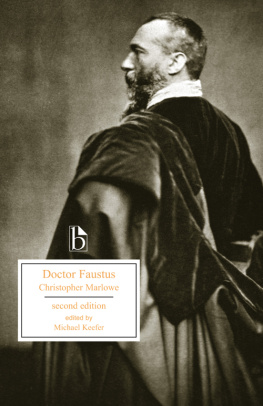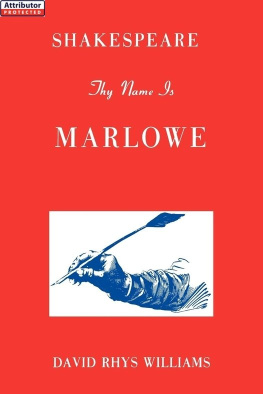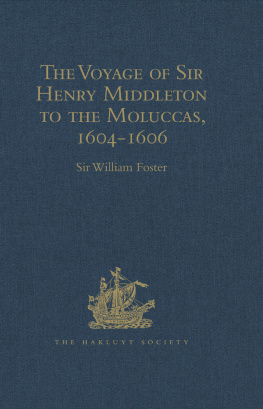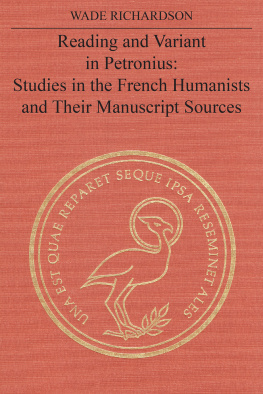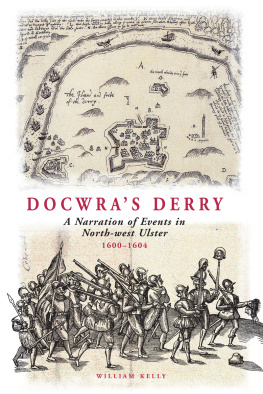DOCTOR FAUSTUS
A 1604-Version Edition
Christopher Marlowe
SECOND EDITION
edited by Michael Keefer

broadview editions
2007 Michael Keefer
All rights reserved. The use of any part of this publication reproduced, transmitted in any form or by any means, electronic, mechanical, photocopying, recording, or otherwise, or stored in a retrieval system, without prior written consent of the publisheror in the case of photocopying, a licence from Access Copyright (Canadian Copyright Licensing Agency), One Yonge Street, Suite 1900, Toronto, ON M5E 1E5 is an infringement of the copyright law.
Library and Archives Canada Cataloguing in Publication
Marlowe, Christopher, 15641593.
Doctor Faustus : a 1604 version edition / edited by Michael Keefer. 2nd. ed.
(Broadview editions)
Previous ed. published in 1991 under title: Christopher Marlowes Doctor Faustus.
Includes bibliographical references.
ISBN 978-1-55111-210-7
I. Keefer, Michael H. II. Title. III. Title: Christopher Marlowes Doctor Faustus. IV. Series.
PR2664.A2K43 2007 822.3 C2006-904074-5
Broadview Editions
The Broadview Editions series represents the ever-changing canon of literature in English by bringing texts long regarded as classics with valuable lesser-known works.
Advisory editor for this volume: Michel Pharand
Broadview Press is an independent, international publishing house, incorporated in 1985. Broadview believes in shared ownership, both with its employees and with the general public; since the year 2000 Broadview shares have traded publicly on the Toronto Venture Exchange under the symbol BDP.
We welcome comments and suggestions regarding any aspect of our publicationsplease feel free to contact us at the addresses below or at .
North America:
PO Box 1243, Peterborough,
Ontario, Canada K9J 7H5
PO Box 1015, 3576 California Road,
Orchard Park, NY, USA 14127
Tel: (705) 743-8990;
Fax: (705) 743-8353 | UK, Ireland, and continental Europe:
NBN Plymbridge
Estover Road
Plymouth PL6 7PY UK
Tel: 44 (0) 1752 202300
Fax: 44 (0) 1752202330 | Australia and New Zealand:
UNIREPS,
University of New South Wales
Sydney, NSW, 2052 Australia
Tel: 61 2 9664 0999
Fax: 61 2 9664 5420 |
E-mail: | E-mail: | E-mail: |
Broadview Press acknowledges the financial support of the Government of Canada through the Book Publishing Industry Development Program (BPIDP) for our publishing activities.
www.broadviewpress.com
Book design and composition by George Kirkpatrick
PRINTED IN CANADA
Preface to the Revised Edition, 2006
Fifteen years have passed since my edition of this play first appeared. This revised edition incorporates a substantially rewritten introduction, updated explanatory notes, and a small number of alterations to the edited text.
When my 1991 edition was first published, I expected that its most controversial feature would be its re-location of two comic scenes which my textual analysis showed to have been displaced in the early quartos of Doctor Faustus (and one or both of which had remained displaced in all subsequent editions of the play). The innovation was accepted by most textual scholarsamong them David Bevington and Eric Rasmussen, who in their Revels Plays edition (1993) expressed the hope that this and other agreements between our editions might be indicative of a new consensus, not only in the editing of this play but of others as well (x).
What proved controversial was my practice, in a critical edition based upon the 1604 quarto (or A text), of printing readings from the 1616 quarto (or B text) in a number of closely parallel passages where I found reason to believe that the 1616 text preserves earlier and more authentic readings. Bevington and Rasmussen indicated the current limits to any new consensus when they contrasted their own (not wholly consistent) attempts to avoid any conflation of the 1604 and 1616 texts with the manner in which my generally laudable edition makes the mistake of moving back and forth for its verbal choices in a way that implies a single underlying text and procedurally seems at times arbitrary (Bevington and Rasmussen x). In this revised edition I have provided explanations in my notes of all points where I have adopted readings of the 1616 text; and in the fifth section of my introduction and in my Note on the Text I have indicated more clearly than before the editorial principles and textual evidence that have guided my choices.
Let me give an anticipatory glimpse of what is at issueand hence, in broad terms, of the differences between the 1604-version text offered here and the texts of Bevington and Rasmussen (and of the other more recent editors who have followed their lead). Bevingtons and Rasmussens edition, no less than my own, presupposes that at some point around 1589 there was indeed a single underlying text of Doctor Faustus. Their aim, like mine, has been to produce a contemporary text that brings readers as close to the moment of originary textual production as the surviving textual and contextual evidence permits. We agree that the 1604 quarto (or A text) provides the best evidence for the play-texts earliest shape, and we agree that the 1616 quarto (or B text) is a composite or sedimented text that incorporates censorship and large-scale revisions dating from the first decade of the seventeenth century.
We differ, however, in our understanding of what the relationship might be between the originary underlying text and the 1604 and 1616 quartos of Doctor Faustus. Bevington and Rasmussen believe the connection between the earliest manuscript of the play and the A text to be very close indeed: in their view, the 1604 quarto was printed from that manuscript, the original foul papers of Marlowe and his collaborator (Rasmussen 31). But as I have indicated in my Note on the Textand as I have argued at greater length in a recent article (Keefer 2006) and in the full critical edition of the 1604 and 1616 versions that is being published by Broadview Press simultaneously with the present Broadview Editions texttheir own textual evidence does not support this conclusion. Moreover, there is compelling evidence that at several points where the A and B texts are closely parallel, the 1616 quarto preserves readings that are demonstrably earlier and better than those of the 1604 quarto.
It follows from this analysis that the early history of the play must be more complex than contemporary textual critics have been willing to acknowledge. The occasional local superiorities of the B text lead to the conclusion (which I arrived at in 1991) that while the 1604 quarto preserves Doctor Faustus in a version that is both earlier and more authentic than the version of the play preserved in the textually composite and sedimented 1616 quarto, and while the 1604 text is in most places superior to the revised and censored 1616 text, the 1616 quarto incorporates some elements of a text of the play that is earlier and better than the text provided by the 1604 quarto.
The task of the critical editor may correspondingly be more complicated than we have tended to assumethough such a conclusion is unlikely to please textual critics of this play, who have historically displayed a strong preference for simple solutions. For much of the twentieth century, the 1616 quarto was regarded as being very close to the true Marlovian thing; the current orthodoxy has awarded the same prize to the 1604 quarto. In both cases, the out-of-favor text has been dismissed and thought to possess little if any substantive value.

